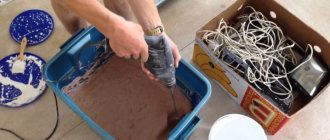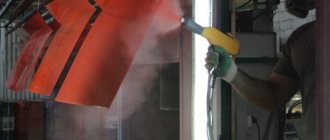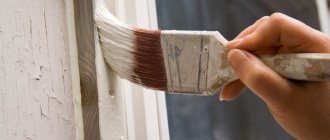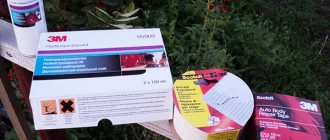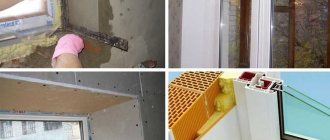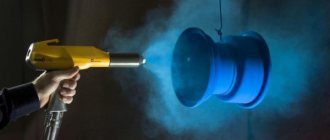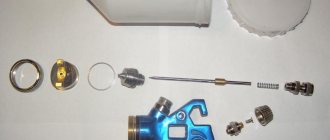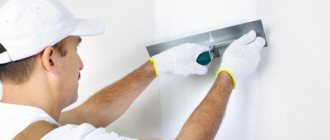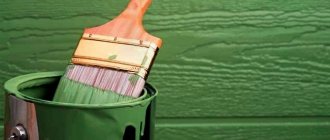The difference between latex and acrylic
First, it’s a good idea to find out how acrylic and latex paints differ, how compatible they are and how they can be mixed.
Latex in an aqueous solution contains rubber colloidal particles (synthetic) and emulsifiers. There are latex paints with natural latex - these are juices:
- poppy,
- Hevea,
- Dandelion.
They cost more, the differences are visible only to a specialist. Rubber particles based on the following bases act as artificial latex:
- Uretanova,
- Siloxanova,
- styrene butadiene,
- Isoprene,
- Acrylate.
Acrylic paint consists of acrylate copolymers and rubber filler, in most cases, styrene-butadiene group. As you can see, latex and acrylic are two boots of a pair - compositions on the same basis.
If you see the name “Acrylic paint with latex”, then don’t rack your brain, they just added butadiene styrene to the acrylic composition. This is done for one purpose - this reduces the cost of coating, since pure acrylic is expensive.
How to choose the right one
First of all, when choosing which paint is best to purchase, you need to decide for what purpose it will be used:
- For finishing ceilings in warm rooms, it is wiser to choose a polyvinyl acetate mixture;
- For smooth walls, matte paints are a priority; glossy compounds are best used for rougher surfaces;
- Acrylic-silicone mixtures are better suited for outdoor work;
- If you are painting wallpaper that is supposed to be washed frequently, it is better to choose latex paint - it is more moisture resistant;
- An important characteristic is the number of abrasion cycles. For indoor work it should not be less than 3 thousand.
- The quality of the paint is affected by the thickening time of the composition - if the mixture thickens slowly, then it is better not to use it for walls, as streaks may form.
Considering the conditions in which the surface to be painted is located and financial capabilities, you can choose either acrylic or latex dye. The main thing is to choose high-quality products from a reliable manufacturer that meet the conditions of finishing work.
Why determine whether the paints on the surface are compatible with the paint used?
Paint and varnish materials often have to be applied to a surface that is already covered with some kind of paint and varnish material. These can be primers, putties, various enamels. They may differ in the pigments included in the composition and in the film-forming base. In order for the surface to be painted successfully, and for it to acquire an attractive appearance, it is necessary to ensure that the materials are compatible with each other.
If you attempt to coat over a material that is not compatible, the resulting surface will be of poor quality. Its appearance will be spoiled, and it is possible that soon after drying the paint will begin to crack and fall off. The composition will need to be removed soon and the painting work will need to be done again. This is not only time-consuming, but also very costly financially.
How to use water correctly
The main key to success is the choice of the most suitable thinner. Completely different substances are used for the process. Most often, ordinary water is used. This is the basis of this product.
If you have chosen water as a diluent, then you need to know exactly what parameters it must meet:
- First of all, you need to pay close attention to temperature readings . Liquid at room temperature is most suitable. If it is necessary to dilute paint for outdoor work, then the temperature of the liquid should be slightly higher than the ambient temperature. It is worth remembering that in hot weather it is necessary to add less liquid: the composition thickens more at low temperatures.
- It is best to dilute with distilled water . It is not necessary to buy such a liquid; you can get it at home; there are many ways to do this. The most popular method of purifying water is boiling it. After this, the liquid should settle.
You can not only make distilled water yourself, but also buy it at any hardware store. You can also buy this type of water at a pharmacy.
On the Internet you can find advice that it is better to dilute using all kinds of solvents. Similar compositions are often used for oil paint. It is worth noting that this absolutely cannot be done. This is completely wrong. If you add oil paint thinner, the mixture will simply curdle. And the worst thing is that such a reaction will not happen immediately. Cleaning the walls will take a long and painful time.
Latex paint and its types
Styrene-butadiene emulsion
The binding element in latex dyes is synthetic rubber based on copolymers.
It gives the raw materials for dyeing the following characteristics:
Latex paint
The types of paints and varnishes, depending on the components in the composition, are presented in the table.
| View | Characteristics | Which finish is it suitable for? |
| Polyvinyl acetate (water-based or water-dispersed) | Made from PVA glue, non-toxic, provides good adhesion to the surface. Disadvantages: unstable, easily washed off with water | For dry rooms |
| Butadiene-styrene | Resistant to water, but fades easily in sunlight | For bathrooms, toilets, corridors, basements |
| Acrylic | High-quality, suitable for interior work, facade finishing and painting exterior elements | For interior and exterior decoration |
| Acrylic-silicone | Reliable facade finishing with high durability | For facades and rooms with high humidity |
| Washable | Based on an acrylate binder polymer | For interior work |
| Rubber acrylate-latex | Creates a coating that is resistant to moisture, UV radiation, and temperature fluctuations, elastic and quick-drying. | For covering tennis courts, swimming pools, running tracks |
For interior work the following are most often used:
- vinyl
- acrylic
- dripless
- textured
- dense
Latex finishing compounds can give different finishing effects: matte, glossy or semi-matte.
Latex materials used:
- For external work (painting facades)
- For interior decoration (for walls and ceilings)
- For painting the floor
- For surface waterproofing
- Universal
What is acrylic paint
It refers to water-dispersed paints and varnishes. If you decipher it, all the features of the paint immediately come to the surface. Water, acrylic resin and tiny particles of coloring pigment are shaken up so that the droplets are evenly distributed among each other - this is called dispersion.
Thus, acrylic paint consists of the following components:
- water,
- acrylic resin,
- dye,
- filler (larger paint particles that make the coating more durable, adhesive, and matte or glossy),
- additional components that make each brand unique.
Operating principle After the paint is applied, it begins to dry - water evaporates from it. Resin droplets connect and create a monolithic layer that reliably embeds the coloring pigment.
Properties after drying
In liquid form, it is a light, almost odorless substance that is easy to apply and also easy to wash off. However, acrylic paint adheres excellently to almost any surface (which makes it universal), be it stone or plastic.
Composition of paints
Both acrylic and latex compositions consist of the following main components:
- Binding ingredients. This is one or more polymers. The quality of the binder determines the service life of the painted coating, adhesion to the surface, abrasion resistance and other physical and mechanical properties.
- Pigments. Serve to give the desired color.
- Fillers. These are substances that make the painted surface glossy or matte and give strength to the paintwork.
- Solvent. This is a liquid base for the dispersed phase.
- Surfactants and additives. These are components that give the paint mixture certain properties so that it can be applied to various materials - wood, glass, concrete, wallpaper, plastic and others.
When choosing a can of paint, you need to carefully study its composition. The qualities of polymers are especially important - there are many of them, and the durability of the painted surface depends on them.
Mixing Rules
If you need to mix several paints (collect the remains into a single whole), then pay attention to the following parameters of the compositions:
- Glossy-matte,
- Bright-pale,
- With or without marble chips,
- Presence of butadiene styrene - no,
- Type of rubber filler (natural-synthetic),
- Consistency.
By mixing gloss and matte composition, you get neither fish nor meat... you can paint a toilet with this paint, but not living rooms. The same applies to the brightness (saturation) of color - do not mix saturated and pale white colors.
Also, water-dispersion and water-based coatings should not be mixed. More on this in a little more detail.
Differences between water emulsion and water dispersion
Water-based dispersion paint consists of water, coloring pigment, polymer particles, as well as binders based on acrylic and silicone resins. The type of water dispersion composition can be acrylic and:
- Mineral,
- Silicone,
- Silicate.
The mineral composition is the most common; this coating contains lime or cement. Plus - low price, minus - fragility. Silicone material will please you with its moisture resistance, and silicate material is not afraid of fungi and mold.
A special emulsion is added to water-based paint - silicone resin, which makes the material wear-resistant and durable. The remaining components of the composition are identical. The advantages of VEC are described above, minus one is the higher price compared to VDK.
Consequences of improper mixing
In short, acrylic paint consists of:
- Binder,
- Copolymers,
- pigment,
- Thinner or solvent,
- filler,
- Additives.
For mixing without consequences, it is necessary that the binder, copolymers, filler and additives from this list match. It is desirable, but not necessary, for the pigments to match.
If you don’t want or don’t have time to study the composition, then take two simple rules into account:
- Mix the same type of paints,
- Do test mixing and test painting.
The following types of paints should not be mixed:
- Water-dispersion and water-emulsion,
- With and without silicone,
- On an organic and synthetic basis,
- Matte with glossy.
If you mix them, then stains are highly likely to appear on the surface, the paint layer will crack or begin to peel off even after priming.
Be sure to do a test mixing using a mixer - if different compositions turn into whey when merging and lose homogeneity, then they are not compatible. It is also important to paint an area of the surface with mixed paints, wait until it dries and evaluate the quality of the paint.
I have a gallon of interior latex paint (with primer mixed) and a gallon of interior acrylic paint (with primer mixed). The color I want is somewhere in between.
Can I mix these two colors together? Will this affect how it dries or how long it will last?
The Internet produces conflicting and confusing results. Also this answer implies that acrylic and latex paints are the same, but I'm not sure that's the same context (I don't know what "waterborne paint" is).
Answers
There is actually no difference between latex and acrylic paints because latex paints have no latex in them. Let me explain. All water-based paints today are called "latex", although there is no latex rubber in the formula at all. . Higher quality paints contain more acrylic resins than vinyl.
Acrylic wall paint is simply thicker, with tinier acrylic beads that bind together as water evaporates. They are pulled and tightened to create a coated surface of plastic polymer. Liquids in paint may contain additives to enhance and thicken this process. The thinner the paint (cheaper), the fewer polymer beads it contains. This solves the problem of having multiple layers to fill in the areas to keep the balls apart. Pigments are colors added to a medium (polymers and liquid). Curing in the case of acrylic paints is simply a drying process where the polymer beads are drawn and tightened. No chemical changes are required other than evaporation. It is not oil based.
No. The color may be good, but you have no idea about the binding properties. And when I say “binding,” it happens not only during, but also after it heals—if it actually heals.
“Can I mix these two colors together?” YES
“Will it affect how it dries or how long it will last?” YES
When mixing "water based" paints (which I have personally done many, many times) you should test it on a representative sample surface to ensure it rolls/brush satisfactorily and dries/cures to the color you want in the time you want. There is no practical way for a home user to check how long it will last.
I am an artist and I create and experiment. I also live on a tight budget. I wanted to paint my old shed to match the new blue-gray siding on my house and I had a can of blue exterior blue paint but it was too bright. I made it gray by adding artist's acrylic paint, tested it on the subject; When it worked, I painted the barn. Everything went smoothly, dried fine, and after 3 seasons, including a harsh winter, it still looks great. However, I don't know how long this will last, but I hope I can afford new paint. The success achieved depends on the color, brand of paint or other factors, but I think it's worth a try and if it didn't work I'd have a different answer for you.

